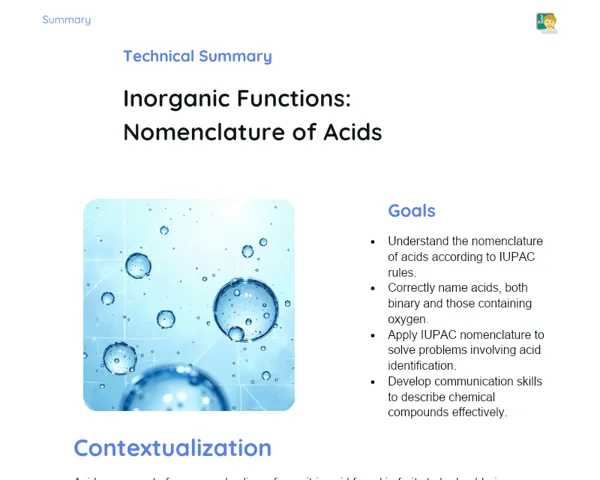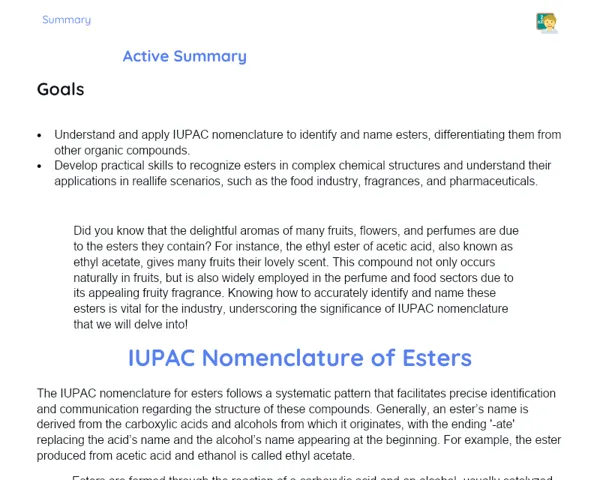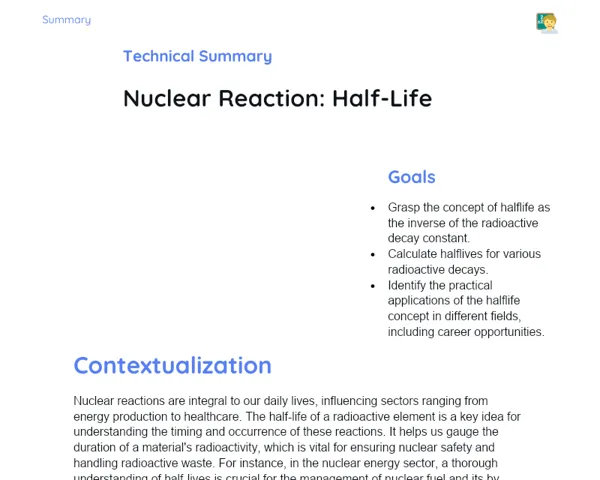Socioemotional Summary Conclusion
Goals
1. Understand that alcohols are organic compounds with a hydroxyl group attached to a carbon.
2. Identify the properties and characteristics of alcohols, such as solubility, boiling point, and reactivity with sodium.
Contextualization
Have you ever noticed how alcohols are a part of our everyday life? Whether it's in the hand sanitizers we use, in the alcoholic drinks we consume, or even in cleaning products we rely on, alcohols are key players in numerous practical applications. By understanding their properties and how they interact with other substances, we can make better and safer choices. Let’s delve into the intriguing chemistry of these compounds that are everywhere around us! 🌟
Exercising Your Knowledge
Definition of Alcohol
An alcohol is an organic compound that contains one or more hydroxyl groups (-OH) linked to a saturated carbon atom. The general formula for alcohols is R-OH, where 'R' stands for an alkyl group that can take various forms, resulting in different types of alcohols. Grasping this structure is vital for understanding how these compounds behave during various chemical reactions.
-
General Structure: Alcohols have a hydroxyl group (-OH) attached to a saturated carbon. This is crucial for defining their chemical and physical traits.
-
Alkyl Group: The 'R' part can vary from simple (like methyl) to complex (like isopropyl), significantly affecting the characteristics of the alcohol.
-
Chemical Importance: The hydroxyl group is key for alcohol's reactivity, allowing a range of reactions, including oxidation and esterification.
Classification of Alcohols
Alcohols can be categorised based on the number of hydroxyl groups they possess. This classification aids in understanding the variations in properties and applications of these compounds. Examples include monoalcohols like ethanol, diols such as ethylene glycol, and triols like glycerol.
-
Monoalcohols: Contain a single hydroxyl group, such as ethanol, commonly found in drinks and fuels.
-
Diols: Feature two hydroxyl groups, like ethylene glycol, used in antifreeze and hydraulic fluids.
-
Triols: Consist of three hydroxyl groups, such as glycerol, widely utilised in pharmaceuticals and cosmetics.
Physical Properties of Alcohols
Alcohols display unique physical characteristics due to the hydroxyl group, enabling the formation of hydrogen bonds. This greatly influences properties like melting point, boiling point, and water solubility.
-
Melting and Boiling Points: Alcohols generally have higher melting and boiling points compared to hydrocarbons of similar molecular weight, due to hydrogen bonding.
-
Solubility: Short-chain alcohols are usually soluble in water, whereas longer chains show reduced solubility. Solubility plays a crucial role in applications within pharmacology and environmental chemistry.
-
Density: The density of alcohols varies with the carbon chain length, affecting their applications across various industries, including oil and gas.
Key Terms
-
Hydroxyl: Functional group (-OH) that is characteristic of alcohols, essential for their chemical and physical properties.
-
Ethanol: A common example of a monoalcohol used in alcoholic drinks and as a fuel.
-
Boiling Points: The temperature at which a liquid transforms into a vapor, influenced by the presence of hydrogen bonds in alcohols.
-
Solubility: The capability of a substance to dissolve in another, influenced by the carbon chain length in alcohols.
For Reflection
-
How does the presence of hydrogen bonds in alcohols affect their solubility and boiling points? Consider the implications in daily life.
-
Think about how understanding the properties of alcohol can help you make safer choices while using cleaning and pharmaceutical products.
-
In what instances in your daily life do you need to practice self-awareness and self-control when using products containing alcohols? How can these socio-emotional skills improve your decision-making in such scenarios?
Important Conclusions
-
Alcohols are organic compounds that feature a hydroxyl group attached to a carbon, playing an important role in various aspects of our lives.
-
The physical properties of alcohols, such as boiling point and solubility, are determined by the hydroxyl group's presence and vary with the carbon chain length.
-
Alcohols can engage in many significant chemical reactions, including oxidation and esterification, which expands their industrial and medicinal applications.
Impacts on Society
Today, alcohols carry a substantial influence on our society. For instance, ethanol is extensively used as an alternative fuel, aiding in lowering emissions and contributing to the battle against climate change. Moreover, the significance of hand sanitizers has surged during the COVID-19 pandemic, underscoring the role of these compounds in promoting public health.
Additionally, many of us feel an emotional connection to alcohols. Responsible consumption of ethyl alcohol at social functions can enhance social bonding and create positive memories. However, it is also important to be mindful and mitigate the risks associated with excessive consumption, prompting us to better understand our emotions and choices. Cultivating effective self-control can help us balance the safe and informed use of these compounds.
Dealing with Emotions
To aid you in managing your emotions while learning about alcohols and their applications, I'd like to suggest an exercise using the RULER method. Take a moment of calm to identify any emotions that surface thinking about the significance of alcohols in your life. Try to determine what prompts these emotions and their potential impact. Accurately naming these feelings – be it curiosity, concern, or enthusiasm – is crucial. You can express these emotions through journaling or by sharing with a friend. Finally, to regulate your emotions, practice techniques like deep breathing or taking strategic breaks during study sessions. This can assist in maintaining focus and enhancing your learning experience.
Study Tips
-
Make vibrant summaries that showcase the properties of various types of alcohol. Use colourful charts and tables to compare their properties.
-
Seek out online videos and experiments demonstrating chemical reactions with alcohols. Practical demonstrations can aid in understanding complex concepts.
-
Form study groups with your peers to discuss, clarify doubts, and review the content together. Exchanging ideas and queries can enrich your learning experience and make studying more engaging.



